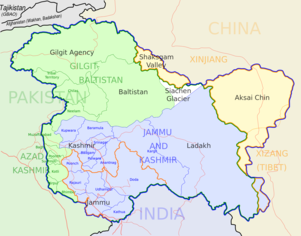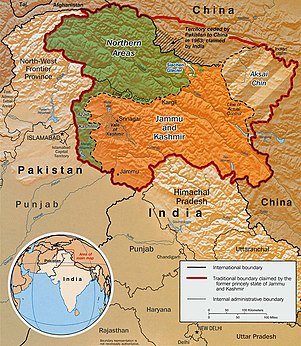Type a search term to find related articles by LIMS subject matter experts gathered from the most trusted and dynamic collaboration tools in the laboratory informatics industry.



The Actual Ground Position Line (AGPL) divides current positions of Indian and Pakistani military posts and troops along the entire 110 kilometres (68 mi) long frontline in the disputed region of Siachen Glacier.[1][2][3][4] AGPL generally runs along the Saltoro Mountains range, beginning from the northernmost point of the (LOC) at Point NJ 9842 and ending in the north on the Indira Ridge at the India-China-Pakistan LAC tripoint near Sia Kangri about 4 km (2.5 mi) northwest of Indira Col West, with peaks in excess of 7,000 m (23,000 ft) and temperatures ranging to around −55 °C (−67 °F).[5][6] India gained control of 1,000 square miles (2,600 km2) of disputed territory in 1984 because of its military operations in Siachen.[7][8] A cease-fire was announced in 2003.[9][10][11]
India has at least 108 forward military outposts and artillery observation posts in this area where temperature goes down to −86 °C (−123 °F) during winters with icy 300 km/h (190 mph) blizzards.[citation needed]Bana Top (6,200 metres (20,500 ft)) is the highest post and requires an 80-kilometre (50 mi) trek that takes up to 20 days for troops to reach. Pahalwan Post (6,100 metres (20,000 ft)), and Indira Col (5,800 metres (19,000 ft)), are other high posts. India has two major bases, each with a brigade strength of five to eight battalions supported by additional artillery, air defence, engineer and other logistic units: Thoise which serves the southern Siachen sector, and Siachen Base Camp which serves the northern and middle sectors of Siachen.[12] Kumar Post, a logistics subbase of Siachen Base Camp, is a 60-kilometre (37 mi) 9-day return trek from Siachen Base camp towards Indira Col.[13] India has significant tactical advantage as it occupies most of the higher peaks on the Saltoro Mountain Range in the western sector of Siachen. The Pakistani Army hold posts at lower heights on the western slopes of the spurs of the Saltoro Ridge. Pakistan has not been able to scale the crest of the Saltoro Range occupied by India.[12] Each post has an artillery officer who are deployed in the rotation of 45 days.[14] The average temperature is between minus 25°C during day and minus 55°C during the night.[15] As of 2013, Siachen operations cost INR 3,000 crore annually where over 850 Indian and over 1,800 Pakistani soldiers have died, mostly not in combat, but due to the weather conditions.[12]
Till 2013, 26 decorations have been awarded to the Indian soldiers in this sectors, including a Paramvir Chakra (PVC), five Mahavir Chakra and 20 Vir Chakra to 11 officers and 15 OR of which nine are posthumous. Additionally, many more Kirti Chakra, Shaurya Chakra, Sena Medal and Vayu Sena Medal have been awarded in this sectors.[12]
The actual India-Pakistan boundary is divided into four types of borders: disputed Sir Creek (SC) riverine border, mutually agreed India–Pakistan International Border (IB) from north of Sir Creek to north of Dhalan near Jammu, LoC across disputed Kashmir and Ladakh regions from north of Dhalan in India and west of Chicken's Neck in Pakistan to Point NJ9842, and Actual Ground Position Line (AGPL) across Siachen from Point NJ9842 to Indira Col West. Siachen lies south of the Shaksgam ceded by Pakistan to China via the 1963 Sino-Pakistan Agreement but also claimed by India[11] and Aksai Chin held by China since 1962 but also claimed by India. The Shaksgam Tract, controlled by China, is located north of the Saltoro mountain range from the Apsarasas Kangri Range to 90 km (56 mi) northwest of K2.[16]
AGPL alignment, from south to north, runs near the following features of the Saltoro Mountains subrange of Karakoram:[10][5][16][6][7][8][17]
The Karachi Agreement of 1949 created the Line of Control between India and Pakistan, but this line ended at a location called Khor in Nubra. The only additional relevant text for the Saltoro – Siachen area in either the 1949 or the superseding 1972 Simla Agreement was "thence north to the glaciers." The countries interpreted that differently, leading to the Siachen conflict.[20]
As part of the Simla Agreement signed on 2 July 1972, prime ministers Indira Gandhi and Zulfikar Ali Bhutto agreed that "the line of control resulting from the ceasefire of December 17, 1971, shall be respected by both sides without prejudice to the recognised position of either side".[21][22]
In November–December 1972, the military delegations of the two sides met in Suchetgarh to delineate the Line of Control. After delineation, signed maps were exchanged by the two sides and submitted to the respective governments for ratification.[23] Scholar Brian Cloughley remarked that the delineation represented remarkable territorial precision. However, it terminated at the grid reference NJ9842, leaving undelimited 60 to 75 km to the border with China.[24]
In 1984 by India's successful captured the disputed Siachen Glacier through its Operation Meghdoot, and subsequently continued with Operation Rajiv. India took control of the 76-kilometre-long (47 mi) Siachen Glacier and its tributary glaciers, as well as all the main passes and heights of the Saltoro Ridge immediately west of the glacier, including Sia La, Bilafond La, and Gyong La. Pakistan controls the glacial valleys and slopes immediately west of the Saltoro Ridge.[25][26]
Indian soldiers, following the often-internationally accepted principal of the highest watershed (mountain peaks and ridges) as the border, have held all of the Siachen Glacier and all its main passes since 1984.[6] India launched Operation Meghdoot in 1984 during the Siachen conflict, and took control of the Siachen Glacier.
Indian Army posts are along the Saltoro Ridge, west of the main Siachen glacier, along a line roughly connecting Gyong La, Bilafond La, Sia La, and Indira Col. Pakistan controls the region west of Saltoro Ridge.[6] India has more than 50 military posts across the length of AGPL which are located almost 3,000 ft above Pakistani posts,[6] with 80 km line of sight visibility range in the clear weather. The Indian soldiers hold on to the heights on the ridge, preventing the Pakistani soldiers from climbing up to the Saltoro Range heights.[16]

The Pakistan Army has base camps at Goma and posts at its Gayari subsector in the sub glaciers southwest of the Saltoro Range, and access on the Baltoro Glacier to the Conway Saddle in the northern extremes of the region.[16] The peaks and passes under Pakistan's control such as Gayari Camp, Chogolisa, Baltoro Glacier, Conway Saddle,[16] Baltoro Muztagh, and Gasherbrum lie west of the AGPL.
India allows several tourist and civilian activities in Siachen area. To exploit the potential for tourism, the government is making ongoing efforts to improve connectivity.[27] There is a recurring planned annual civilian expedition from Siachen Base Camp to Indira Ridge, Indira Col and other features. India has opened up the entire area from Siachen Base Camp at 12,000 ft to Kumar Post at 15,000 ft for the regular tourism for the civilians. Bana Post at 20,500 ft will remain off limit to tourists. Temperatures drop to below minus 60 degrees Celsius during the winter.[27]
Until 2010, civilian tourists were permitted only in the Nubra Valley up to Panamik. Since 2010 tourist have been permitted in Nubra Valley up to Turtuk and beyond to Tyakshi on the LAC; both of these villages were captured from Pakistan by India in Indo-Pakistani War of 1971. From 2019, medically fit civilians below the age of 45 are allowed up to Kumar Base (16,000 ft) on a 30-day trek organised by Army Adventure Cell in August–September, during which tourists go through the highly altitude conditioning at Leh Base, Siachen Base and forward staging posts, at the end of which they undertake an extreme adventure 9-day return track from Siachen Base to Kumar Base 60 km away.[13]
In 2018, five road routes and four trails with a night stay in Ladakh were opened for the tourists by the Government of India (GoI), all located above the altitude of 14,000 ft, and the maximum limit of travel permit was raised from 7 days to 15 days:[28]